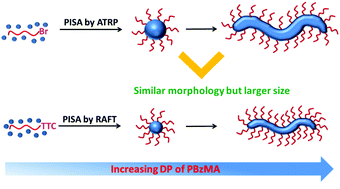Synthesis of diblock copolymer nano-assemblies by PISA under dispersion polymerization: comparison between ATRP and RAFT†
Abstract
Diblock copolymer nano-assemblies of poly(2-hydroxypropyl methacrylate-b-benzyl methacrylate) (PHPMA-b-PBzMA) were synthesized by initiators for continuous activator regeneration atom transfer radical polymerization (ICAR ATRP) using the CuIIBr2/tris(pyridin-2-ylmethyl)-amine (TPMA) complex as a catalyst under dispersion conditions and were compared with those obtained by RAFT dispersion polymerization. It is found that these two kinds of polymerizations afford good control, as indicated by the linearly increasing molecular weight with monomer conversion and the narrow molecular weight distribution, whereas the ICAR ATRP runs a little faster than RAFT. In the two cases of dispersion polymerization, the morphologies of the PHPMA-b-PBzMA nano-assemblies are similar to each other and change from spheres to wormlike aggregates with block extension, whereas the size of the nano-assemblies by ICAR ATRP is usually larger than those obtained by RAFT. The degree of polymerization (DP) of the poly(2-hydroxypropyl methacrylate) and poly(benzyl methacrylate) blocks affecting the size and/or morphology of the PHPMA-b-PBzMA nano-assemblies is investigated, and the reason for the larger size of the PHPMA-b-PBzMA nano-assemblies by ICAR ATRP is discussed.



 Please wait while we load your content...
Please wait while we load your content...